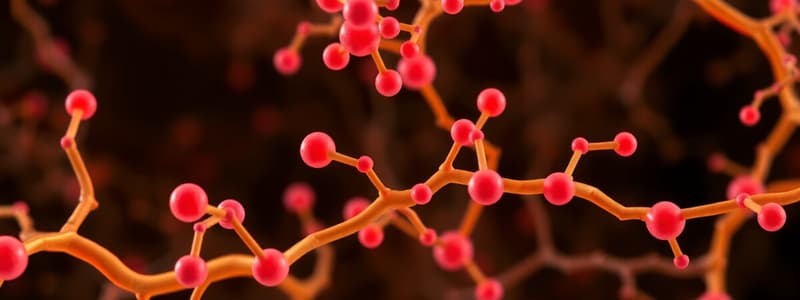Podcast
Questions and Answers
Which area of the hypothalamus is responsible for stimulating appetite?
Which area of the hypothalamus is responsible for stimulating appetite?
- Paraventricular nucleus
- Suprachiasmatic nucleus
- Lateral hypothalamic area (correct)
- Ventral medial nucleus
Leptin secretion increases appetite by stimulating orexigenic neurons.
Leptin secretion increases appetite by stimulating orexigenic neurons.
False (B)
What type of neurons release proopiomelanocortin (POMC)?
What type of neurons release proopiomelanocortin (POMC)?
Anorexigenic neurons
Which neurocrine is known to stimulate gastrin release from G cells?
Which neurocrine is known to stimulate gastrin release from G cells?
Ghrelin is secreted by ______ cells and increases appetite.
Ghrelin is secreted by ______ cells and increases appetite.
Match the following substances with their effects on appetite:
Match the following substances with their effects on appetite:
Vasoactive intestinal peptide (VIP) stimulates gastric H+ secretion.
Vasoactive intestinal peptide (VIP) stimulates gastric H+ secretion.
Which of the following hormones is known to inhibit ghrelin secretion?
Which of the following hormones is known to inhibit ghrelin secretion?
What is the primary function of enkephalins in the GI tract?
What is the primary function of enkephalins in the GI tract?
Vasoactive intestinal peptide (VIP) is homologous to ______.
Vasoactive intestinal peptide (VIP) is homologous to ______.
What is the approximate number of amino acids in vasoactive intestinal peptide (VIP)?
What is the approximate number of amino acids in vasoactive intestinal peptide (VIP)?
Match the following neurocrines with their primary effects:
Match the following neurocrines with their primary effects:
________ is secreted by pancreatic islet cell tumors and mediates pancreatic cholera.
________ is secreted by pancreatic islet cell tumors and mediates pancreatic cholera.
Flashcards are hidden until you start studying
Study Notes
Neurocrines Overview
- Synthesized in neurons of the gastrointestinal (GI) tract and transported down axons.
- Released via action potentials and diffuse across synaptic clefts to target cells.
- Key neurocrines include vasoactive intestinal peptide (VIP), neuropeptide Y, nitric oxide (NO), gastrin-releasing peptide (GRP), and enkephalins.
Vasoactive Intestinal Peptide (VIP)
- Composed of 28 amino acids and homologous to secretin.
- Secreted from mucosal and smooth muscle neurons in the GI tract.
- Causes relaxation of GI smooth muscle, including the lower esophageal sphincter.
- Stimulates pancreatic bicarbonate (HCO3-) secretion and inhibits gastric acid (H+) secretion.
- Associated with pancreatic islet cell tumors, linked to pancreatic cholera.
Gastrin-Releasing Peptide (GRP)
- Released by vagus nerves that innervate G cells in the stomach.
- Stimulates gastrin release, promoting gastric acid secretion and digestive processes.
Enkephalins
- Includes met-enkephalin and leu-enkephalin, secreted by mucosal and smooth muscle nerves in the GI tract.
- Induces contraction of GI smooth muscles, particularly lower esophageal, pyloric, and ileocecal sphincters.
- Inhibits fluid and electrolyte secretion in the intestines, making opiates useful in treating diarrhea.
Satiety Mechanisms
- Hypothalamic Centers:
- Satiety center located in the ventromedial nucleus inhibits appetite.
- Feeding center located in the lateral hypothalamic area stimulates appetite.
Anorexigenic Neurons
- Release proopiomelanocortin (POMC), reducing appetite.
Orexigenic Neurons
- Release neuropeptide Y (NPY), stimulating appetite.
- Key Hormones:
- Leptin is secreted by fat cells; it stimulates anorexigenic neurons and inhibits orexigenic neurons, decreasing appetite.
- Insulin and GLP-1 from the intestines inhibit appetite.
- Ghrelin produced by gastric cells stimulates orexigenic neurons and inhibits anorexigenic neurons, increasing appetite.
- Peptide YY inhibits ghrelin secretion, ultimately decreasing appetite.
Studying That Suits You
Use AI to generate personalized quizzes and flashcards to suit your learning preferences.




